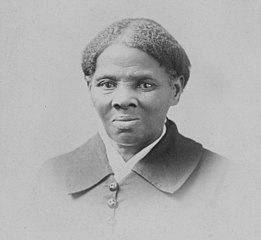Harriet Tubman Biography
The Escape!
Back to Biographies
Harriet Tubman had established a decent life for herself while under the tyranny of slavery. She had work she enjoyed, was able to make extra money, and was married to a free black man. However, there was always a dark cloud hanging over her head. At any moment she could be sold to another enslaver and forced to leave everything.
Harriet began to hear rumors that her current enslavers were in deep debt and needed to sell Harriet and her brothers to stay afloat. Enslavers from the South would arrive any day to take them South and put them to work in the cotton fields. Harriet spoke to her brothers and they agreed, it was time to run.
 Harriet Tubman
Harriet Tubman Author: Unknown
First Attempt
Sometime during September of 1849, Harriet and her brothers took off north in the middle of the night. However, soon her brothers became scared. Where were they going? What would they eat? What if they got lost or caught? They wanted to turn back. Harriet tried to argue with them, but they were determined. The group headed back home.
All Alone
A few days later, Harriet realized she still had to run. Even if her brothers and husband wanted to stay, she had to have her freedom. It would be a long and dangerous trip by herself, but she was willing to take the risk.
In the middle of the night Harriet quietly snuck out of her cabin. She didn't say goodbye to her husband for fear that he would stop her or turn her in. She packed light, bringing only some food and a precious quilt she had made herself.
Making Her Way North
Over the years, Harriet had gathered information about people who would help fugitive enslaved people escape north. Many of these people were religious people called Quakers who wanted slavery to be abolished. On the first part of her journey, Harriet stayed with a white woman. The woman gave her directions to the next stop and a piece of paper with names on it. Harriet was illiterate and could not read the names. The names were code words that would verify that Harriet was a legitimate enslaved person trying to find her way to freedom. Harriet gave the woman her quilt and then began to travel to the next stop.
A Dangerous Trip
The way north was filled with dangers. Harriet's master had put out posters describing her and offering a reward. If anyone recognized her, she would be severely punished. As Harriet made her way from station to station along the Underground Railroad, she learned to disguise herself. She brought a book and would pretend to read if someone began paying her too much attention. This added to her disguise as she was described as "illiterate" in the poster. At safe houses she would sweep the porch or do other chores in order to look like another house servant.
Harriet didn't share a lot of details about the people who helped her, the route she took, or the homes where she hid. This was part of the secrecy of the Underground Railroad. Sometimes a Quaker conductor would take Harriet part way in a wagon, other times she walked at night following the North Star. Eventually, after traveling around 90 miles, Harriet crossed the Mason-Dixon line into Pennsylvania and freedom.
Later Harriet would describe how she felt upon crossing the border into Pennsylvania:
"When I found I had crossed that line, I looked at my hands to see if I was the same person. There was such a glory over everything; the sun came like gold through the trees, and over the fields, and I felt like I was in Heaven"
After crossing north, Araminta needed a new name. It was around this time that she changed her first name to Harriet in honor of her mother, but she kept Tubman's last name.
Harriet Tubman Biography Contents
- Overview and Interesting Facts
- Born into Slavery
- Early Life as an Enslaved Person
- Wounded!
- Dreaming About Freedom
- The Escape!
- The Underground Railroad
- Freedom and the First Rescue
- The Conductor
- The Legend Grows
- Harper's Ferry and the Civil War Begins
- Life as a Spy
- Life After the War
- Later Life and Death
Back to Biographies
More Civil Rights Heroes:
Susan B. Anthony
Cesar Chavez
Frederick Douglass
Mohandas Gandhi
Helen Keller
Martin Luther King, Jr.
Nelson Mandela
Thurgood Marshall
Rosa Parks
Jackie Robinson
Elizabeth Cady Stanton
Mother Teresa
Sojourner Truth
Harriet Tubman
Booker T. Washington
Ida B. Wells
More women leaders:
Works Cited
|
